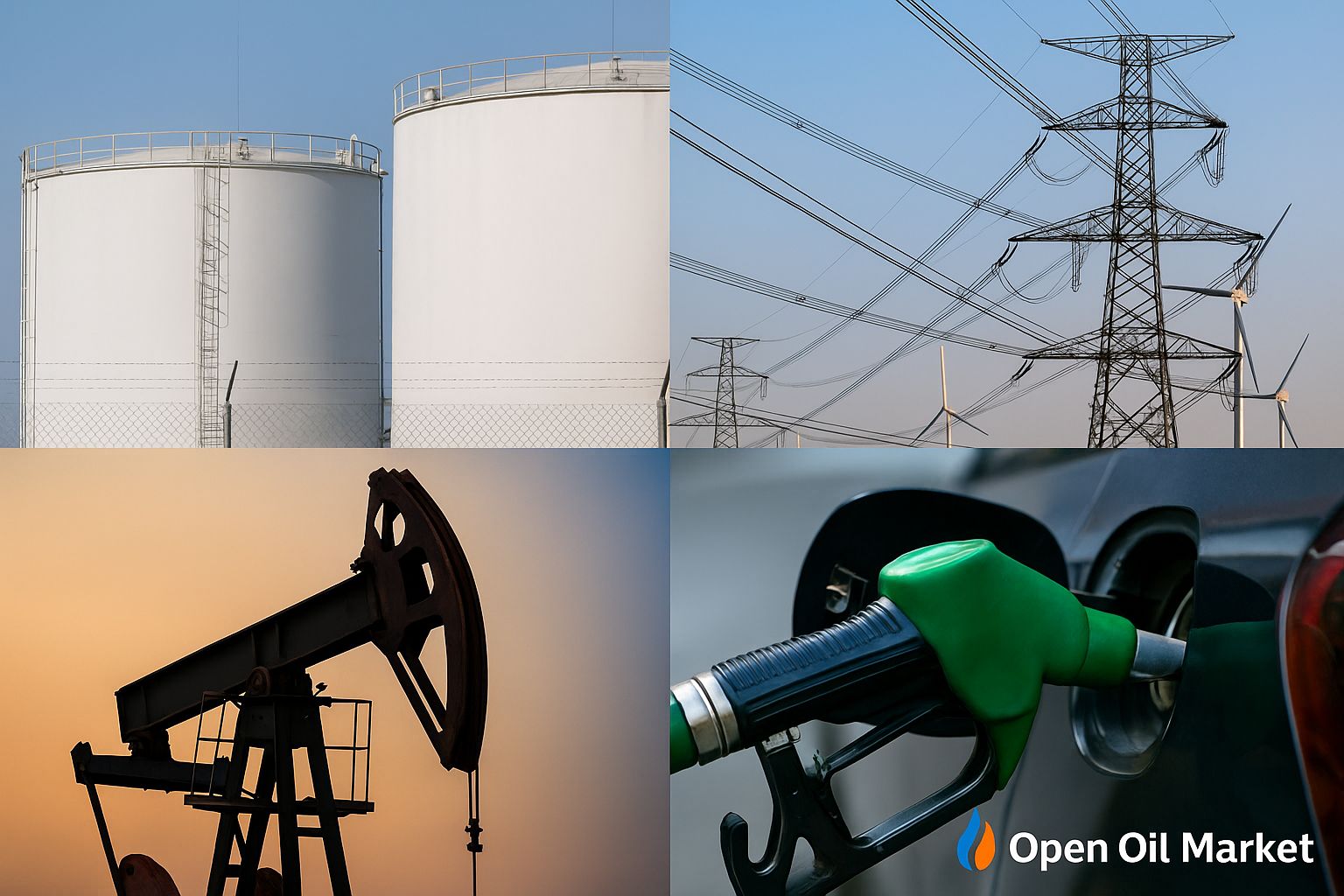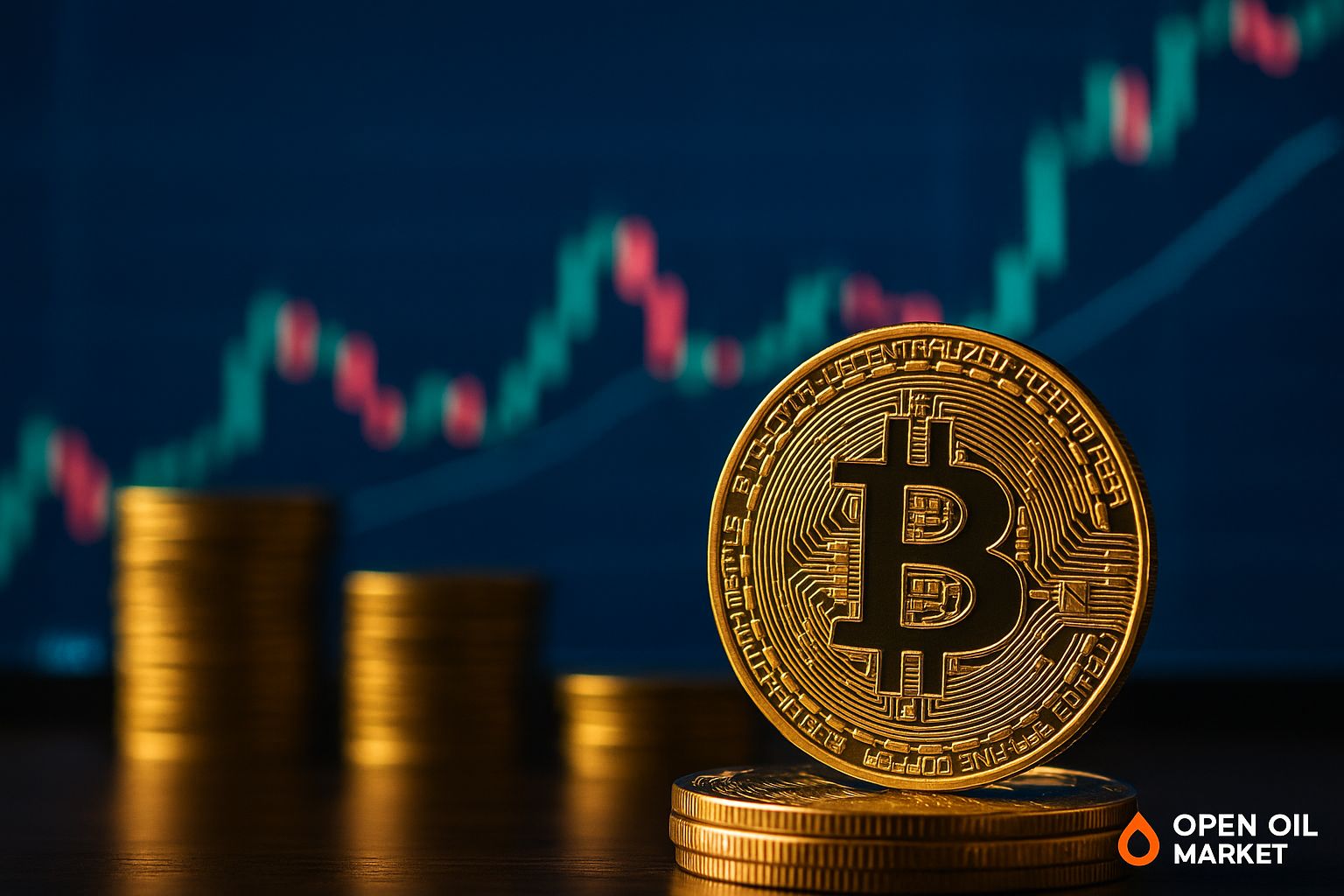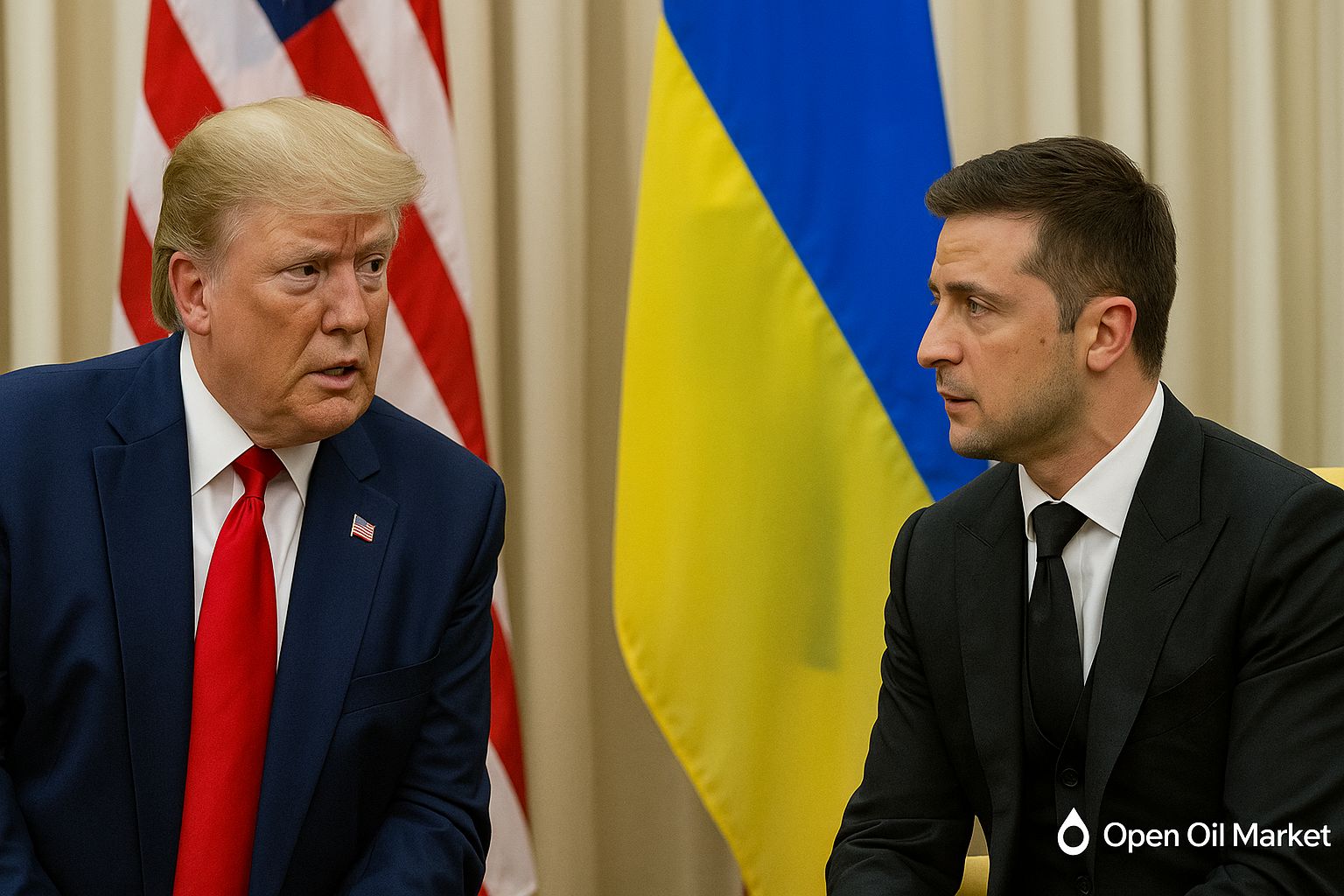
Energy Sector News – Tuesday, August 19, 2025: A Breather in the Sanction Standoff; Resilience of Commodity Markets
As of August 19, 2025, the agenda for the fuel and energy complex (FEC) intertwines geopolitical shifts and market trends, fostering cautious optimism among market participants. The outcomes of the summit between Russia and the United States in Alaska have established a favorable backdrop; however, only tangible actions can confirm the real results of this meeting. Meanwhile, U.S. President Donald Trump stated that he does not plan to impose new sanctions against Russia—offering hope for a respite in the sanctions standoff. The oil market continues to grapple with rising supply amidst slowing demand, with Brent crude prices hovering around the mid-$60 per barrel, indicating a fragile equilibrium of factors. The European gas market portrays reliable stability: gas storage levels in EU countries have exceeded 90%, providing a buffer before the winter season while maintaining prices at moderate levels. At the same time, the global energy transition is gaining momentum—new records for renewable energy generation are being set in several regions, although governments still rely on traditional resources to ensure the reliability of their energy systems. In Russia, after an unprecedented surge in motor fuel prices in early August, emergency government measures are gradually cooling the market: the situation with gasoline and diesel supply is starting to stabilize. Below is a detailed overview of key news and trends across the segments of oil, gas, electricity, and commodity markets as of this date.
Oil Market: Supply Surplus and Weak Demand Keep Prices in Check
Global oil prices maintain relative stability under the influence of fundamental factors. The North Sea benchmark Brent is trading around $65–66 per barrel, while U.S. WTI is in the $62–64 range. Current levels are approximately 10–15% lower than a year ago, reflecting a gradual market correction following the peaks of the energy crisis of 2022–2023. Several important factors simultaneously influence price dynamics:
- OPEC+ Production Increase. The oil alliance is methodically increasing supply to the global market. In August 2025, the total production quota for key participants in the deal was raised by approximately 548,000 barrels per day, with a comparable step expected in September. Since spring, restrictions have been progressively eased, leading to an increase in global oil and petroleum product stocks.
- Slowing Demand Growth. Global oil consumption is growing at a more moderate pace. The International Energy Agency (IEA) has downgraded its demand growth forecast for 2025 to around +0.7 million barrels per day (compared to over 2.5 million barrels per day in 2023). OPEC’s estimates are similarly restrained at approximately +1.3 million barrels per day. Contributing factors include a weakened global economy and the effect of previous high prices stimulating energy conservation. An additional factor is slowing industrial growth in China, limiting the appetite of the world’s second-largest oil consumer.
- Geopolitical Uncertainty. The market is pricing in conflicting risks amid international negotiations. On one hand, the lack of breakthroughs in the U.S.-Russia summit indicates the persistence of sanction pressures (the European Union is simultaneously preparing the 19th package of restrictions), sustaining some “risk premium” in prices. On the other hand, the mere continuation of dialogue and the pause in the introduction of new U.S. sanctions slightly alleviate tensions. As a result, oil prices oscillate within a narrow range, lacking momentum for either a rally or a collapse.
The cumulative impact of these factors creates an excess supply over demand, keeping the oil market close to surplus. Brent prices remain firmly below last year's highs. Several analysts believe that if current trends persist, the average price of Brent could drop to the $50–55 per barrel range by 2026.
Gas Market: Europe Prepares for Winter with Record Supplies
The gas market is centered on Europe, which is confidently preparing for the upcoming heating season. EU countries are rapidly filling natural gas underground storage: according to the latest data, the average storage level has exceeded 90%, significantly ahead of schedule and last year’s figures. The achieved reserves ensure a high level of energy security and currently smooth out price fluctuations—spot prices at hubs remain within a moderate corridor, significantly lower than the peaks of 2022. In case of a cold winter, Europe expects to cover increased demand using accumulated reserves and the ongoing import of liquefied natural gas (LNG). At the same time, caution remains: any unforeseen situations, such as abnormal frosts or supply interruptions, could lead to a brief spike in prices. Nonetheless, for now, the gas market in the region appears balanced and resilient, instilling confidence in participants ahead of the winter months.
International Politics: U.S.-Russia Dialogue Inspires Hopes for Cooperation
External political factors continue to significantly influence the energy sector. On August 15, a meeting took place in Anchorage, Alaska, between the presidents of Russia and the United States. Although no breakthrough agreements were reached as a result of the summit, both sides expressed their readiness to continue dialogue on key issues—from the resolution of the Ukrainian conflict to trade and sanctions. This week, market attention is focused on further steps: on Monday, Donald Trump met in Washington with Volodymyr Zelensky, while the European Union is discussing new restrictive measures against Russia. The U.S. leader's statement that he currently does not plan to impose additional sanctions or tariffs has been a positive signal for investors and has somewhat reduced tensions.
Thus, the political dialogue between Moscow and Washington provides at least a small reprieve for the markets. Geopolitical risks have somewhat diminished; however, the further dynamics of sanctions and cooperation will depend on concrete decisions by the parties in the near future.
Asia: India and China – Balancing Imports and Domestic Production
- India. Facing sanctions pressure, New Delhi has made it clear that a sharp reduction in imports of Russian oil and gas is unacceptable due to the key role of these supplies in national energy security. Indian buyers have secured more favorable terms: Russian companies are compelled to offer an additional discount on Urals oil (around $5 to the Brent price) to retain the Indian market. As a result, India continues to actively purchase Russian oil on favorable terms and increases imports of petroleum products from Russia to meet rising demand. At the same time, the country's leadership is taking steps to reduce long-term dependence on external sources. Prime Minister Narendra Modi announced on Independence Day (August 15) the launch of a national program for the exploration of deep-sea oil and gas fields. As part of this, the state-owned company ONGC has begun drilling ultra-deep wells (up to 5 km) in the Andaman Sea, with initial results assessed as promising. This “deep-sea mission” is aimed at driving the discovery of new hydrocarbon reserves and bringing India closer to its goal of energy independence.
- China. The largest economy in Asia is also increasing energy imports while simultaneously boosting domestic production. Chinese importers remain leading purchasers of Russian oil and gas: Beijing has not joined Western sanctions and capitalized on the situation, continuing to import raw materials at favorable prices. According to Chinese customs statistics, in 2024, the country imported around 212.8 million tons of oil and 246.4 billion cubic meters of natural gas—these volumes grew by 1.8% and 6.2%, respectively, compared to the previous year. In 2025, imports continue to grow, albeit at a more moderate pace due to a high base. Simultaneously, Beijing is encouraging its own oil and gas production: from January to July 2025, national companies extracted 126.6 million tons of oil (+1.3% year-on-year) and 152.5 billion cubic meters of gas (+6%). The increase in domestic production helps partially meet the rising demand but does not negate the need for imports. Chinese authorities continue to invest in developing fields and technologies to enhance well productivity. Given the scale of the economy, China's reliance on energy imports will remain substantial; analysts estimate that in the coming years, the country will import at least 70% of its oil consumption and about 40% of its gas.
Thus, the two largest Asian consumers—India and China—will continue to play a crucial role in the global commodity markets, blending overseas supply with the development of their resource base.
Energy Transition: Renewable Energy Records and the Role of Traditional Generation
The global shift towards clean energy is rapidly accelerating. In European countries, by the end of 2024, the total electricity generation from solar and wind plants for the first time surpassed generation from coal and gas-fired power plants. This trend continued in 2025: the commissioning of new renewable power capacities increases the share of “green” electricity, while the role of coal in the EU's energy balance is decreasing (after a temporary rise during the 2022–2023 crisis). In the United States, renewable energy also reached record levels—at the beginning of 2025, over 30% of all generation came from renewables, and the total output from wind and solar exceeded that from coal-fired power plants for the first time. China, being the global leader in installed renewable capacity, adds tens of gigawatts of new solar panels and wind turbines annually, continuously breaking its own records for “green” electricity. According to the IEA, total investments in the global energy sector are expected to exceed $3 trillion in 2025, with more than half of this amount directed toward renewable projects, grid modernization, and energy storage systems.
At the same time, energy systems still rely on traditional generation to ensure stability. The growing share of solar and wind creates challenges in balancing the grid during hours when renewables do not generate energy (at night or during calm weather). To meet peak demand and reserve capacity, operators sometimes need to increase output from gas and even coal-fired power plants. For instance, in certain regions of Europe during the past winter, some coal stations were temporarily brought back online during prolonged windless periods despite the environmental costs. To enhance energy supply reliability, governments are investing in energy storage systems (industrial batteries, pumped-storage hydroelectric plants) and smart grids capable of flexibly responding to variations in generation. Experts predict that by 2026–2027, renewable sources may surpass coal in terms of electricity generation worldwide, definitively outpacing it. However, in the coming years, there remains a need to keep some conventional power plants on standby as a safeguard against interruptions. Thus, the energy transition is reaching new heights but requires a delicate balance between “green” technologies and traditional resources.
Coal: Stable Demand Amid Moderate Prices
Despite the vigorous development of renewable energy, the global coal market continues to rely on high demand and remains an essential part of the global energy balance. The consumption of coal is particularly high in the Asia-Pacific region, where economic growth and electricity needs support the intensive use of this fuel. China, the world's largest consumer and producer of coal, in 2025 is burning coal at levels close to record highs. Chinese mines extract over 4 billion tons of coal annually, barely sufficient during peak load periods (for instance, during hot summers with widespread air conditioning use). India, possessing substantial reserves, is also increasing coal use: over 70% of the country's electricity is generated from coal-fired power plants, and absolute consumption is rising alongside the economy. Other developing countries in Asia (Indonesia, Vietnam, Bangladesh, etc.) are also implementing projects for new coal-fired power plants to meet the growing demand of the population and industries.
Supply in the global coal market has adjusted in recent years to accommodate high demand. Major exporters—Indonesia, Australia, Russia, and South Africa—have increased production and export of thermal coal, leading to prices returning to more normalized levels after the spikes of 2022, and they are now fluctuating within a narrow range. The balance of supply and demand appears well-matched: consumers are getting the necessary fuel, while producers enjoy stable sales at profitable prices. Although many countries declare plans for a gradual reduction in coal usage for climate goals, in the short term, this resource remains indispensable for energizing billions of people. Experts agree that in the next 5-10 years, coal generation, especially in Asia, will retain a significant role despite global decarbonization efforts. In other words, the coal sector is currently experiencing a period of relative equilibrium: demand is consistently high, prices are moderate, and the industry remains a cornerstone of global energy.
Russian Oil Products Market: Government Measures Stabilize the Situation
In the domestic fuel market of Russia, signs of stabilization have emerged after a sharp price spike in early August, thanks to government intervention. In the initial weeks of the month, wholesale exchange prices for gasoline and diesel reached historic highs, surpassing even the peaks of 2023. Amid the seasonal surge in summer demand (the holiday travel season and active harvest campaign), limited fuel supply led to local shortages and speculative price increases. Additional negative influences included unscheduled shutdowns at several oil refineries due to accidents and drone attacks, which reduced gasoline production. The government promptly responded to the situation with a package of measures to normalize the environment.
On August 14, a meeting of the monitoring headquarters for the situation in the fuel and energy sector was held under the chairmanship of Deputy Prime Minister Alexander Novak, where a package of measures aimed at reducing price agitation was announced, including:
- Extension of the fuel export ban. The comprehensive export ban on gasoline and diesel imposed in early August has been extended until the end of September and applies to all producers, including vertically integrated oil companies. This measure aims to increase supply in the domestic market by those volumes that previously went abroad.
- Partial resumption of exports in October. It is planned that, upon stabilization, the largest oil refineries will be allowed to partially resume exports starting in October. However, the export embargo is likely to remain in place for independent oil depots, traders, and small refineries until complete normalization of the situation.
- Increased control over fuel distribution. Authorities have tightened monitoring of petroleum products' distribution within the country. Factories are instructed to prioritize meeting domestic market needs and avoid mutual exchange purchases that previously drove prices up. The Ministry of Energy, together with the Federal Antimonopoly Service and the St. Petersburg International Commodity Exchange, are exploring a transition to direct contracts between refineries and distribution companies, bypassing exchange mechanisms to eliminate unnecessary intermediaries.
- Subsidies and damping mechanisms. The government continues to provide financial compensation to oil companies—in the form of budget subsidies and reverse excise taxes (“dampers”)—to reimburse them for some of the lost export revenue and stimulate the redirection of adequate volumes of gasoline and diesel to the domestic market.
The combination of these measures aims to stabilize prices and prevent fuel shortages for consumers. The extension of the export ban in the near future will allow an additional 200,000 to 300,000 tons of gasoline and diesel to be directed to the domestic market (the volumes that were previously exported monthly). Meanwhile, subsidies are intended to support the profitability of supplies at gas stations within the country. Authorities assure that they will act proactively: if the situation demands, restrictions on oil products exports will be extended again, and fuel from reserves will be promptly directed to the regions.
At present, the “fuel crisis” is being managed: despite extreme wholesale prices, retail prices at gas stations have risen by approximately 5% since the beginning of the year, which is close to the overall inflation level. The government intends to prevent a repeat of last year's scenario, when a sharp price increase in certain regions severely impacted motorists and agricultural producers. Currently, most gas stations are adequately supplied with fuel, and the steps taken are gradually cooling the wholesale fuel market. Monitoring of the situation continues at the highest level—relevant ministries and the cabinet are prepared to introduce new mechanisms to ensure stable fuel supplies for the country and keep prices within acceptable limits for end consumers.
Telegram Channel OPEN OIL MARKET – Daily Analytics on the Fuel and Energy Market
To stay updated on the latest events and trends in the fuel and energy market, subscribe to our Telegram channel @open_oil_market. There, you will find daily reviews, industry insights, and only verified facts without excessive information noise—everything essential for investors and FEC professionals in a convenient format.




